To create successful natural oil blends for soap, you'll need to balance your essential oils using the 25-50-25 ratio of top, middle, and base notes. Mix 1 teaspoon of clay per pound of oils to anchor your scents effectively. Keep your total usage rates at 0.7 ounces per pound for cold process and 0.3 ounces for hot process soap. For the best results, consider flash points above 170°F. Master these fundamentals, and you'll reveal the secrets of lasting natural fragrances.
Understanding Essential Oil Notes and Their Roles in Soap Making
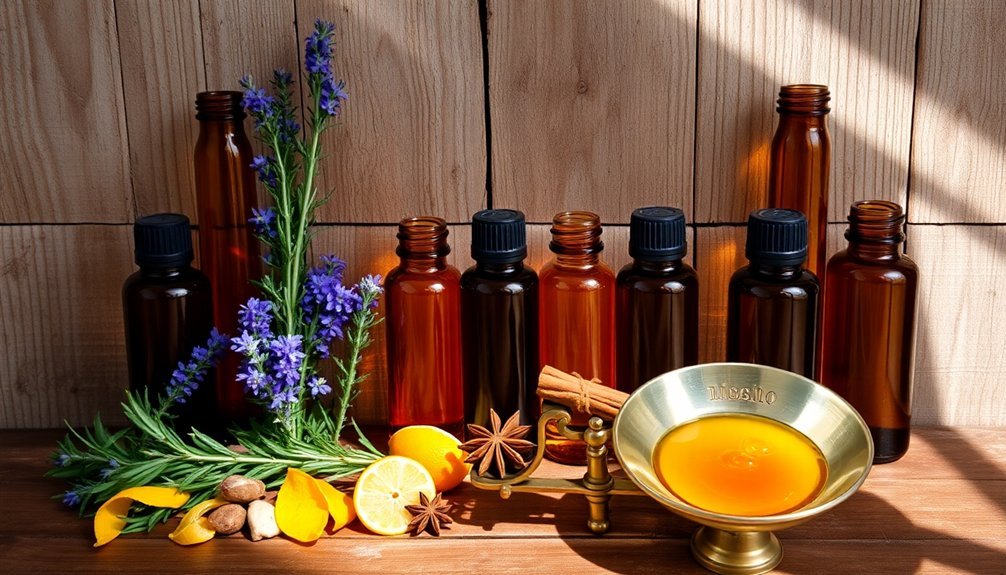
When crafting soap with essential oils, you'll need to understand the three distinct note categories that create a well-balanced fragrance profile.
Top notes, like citrus oils, provide the initial burst of freshness but fade quickly. Middle notes offer warm, soft aromas that create harmony in your essential oil blends, while base notes anchor the fragrance with intense, long-lasting scents.
For ideal scent retention and balance, combine these notes using a 25-50-25 ratio: 25% top notes, 50% middle notes, and 25% base notes.
Choose high-quality essential oils to guarantee your soap maintains its fragrance longer. You'll achieve the best results by pairing complementary scents, such as combining floral middle notes with woody base notes or citrus top notes, creating a complex and sophisticated aroma that enhances your handcrafted soap.
Selecting Base Notes for Long-Lasting Fragrance Retention
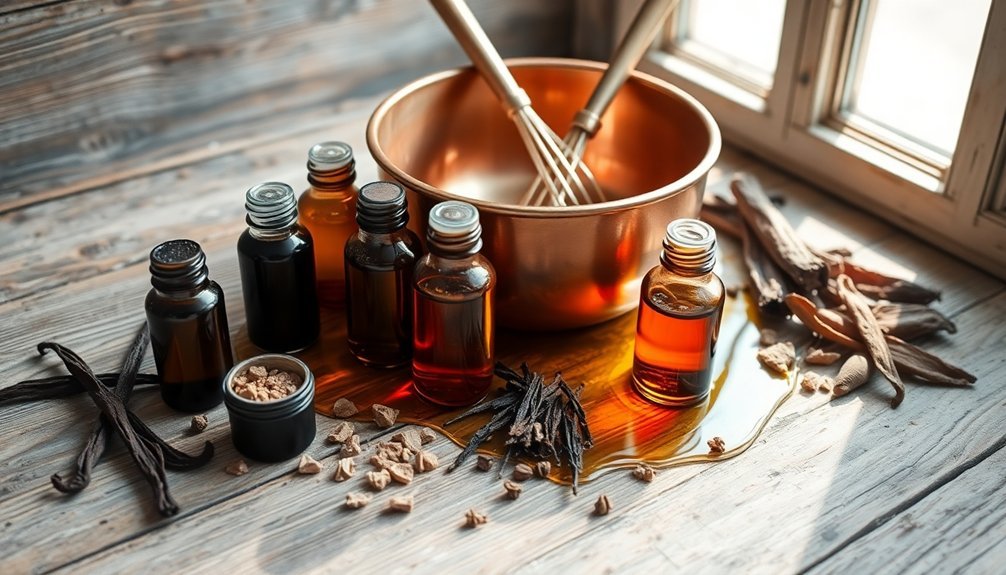
You'll find that anchoring your base notes with natural clays, particularly bentonite or kaolin, creates a stronger bond that enhances fragrance retention in your handcrafted soaps.
When selecting base note combinations, pair deep earthy oils like patchouli with rich resins such as benzoin or frankincense to establish a stable foundation for your blend.
The synergy between these heavier oils works especially well when you combine no more than three base notes, allowing each scent to contribute its unique staying power while maintaining a balanced aroma profile.
Anchoring With Clay Methods
Creating lasting fragrances in handmade soap requires strategic anchoring techniques that combine natural clays with carefully selected base notes.
You'll want to incorporate Kaolin or Bentonite clay at 1 teaspoon per pound of oils to enhance scent retention in your soap formulations.
For best results, mix your fragrance blends with clay before adding them to your soap batch. This guarantees even distribution and better integration of your chosen scents.
When working with thicker base notes like Benzoin, Patchouli, or Frankincense, you may need to gently heat or dilute them for smoother incorporation.
Choose base notes with higher flash points, such as Vetiver and Oakmoss, to minimize scent evaporation during the soap-making process.
These natural fixatives work synergistically with clay to anchor your fragrances and create lasting aromas in your finished soap.
Optimal Base Note Combinations
Building upon clay anchoring methods, successful fragrance retention relies on selecting the right combination of base notes.
You'll want to focus on essential oil blends that incorporate Benzoin, Patchouli, Frankincense, Oakmoss, or Vetiver for ideal combinations that anchor your soap's scent effectively.
For the best fragrance integration, include base notes at 25-50% of your total blend.
You'll need to check flash points from your suppliers to guarantee stability in your soap formulations. Since these oils are typically viscous, you might need to gently heat or dilute them before mixing.
When combining multiple base notes, consider their individual fixative qualities and how they'll work together.
Building Balanced Blends With Middle and Top Notes
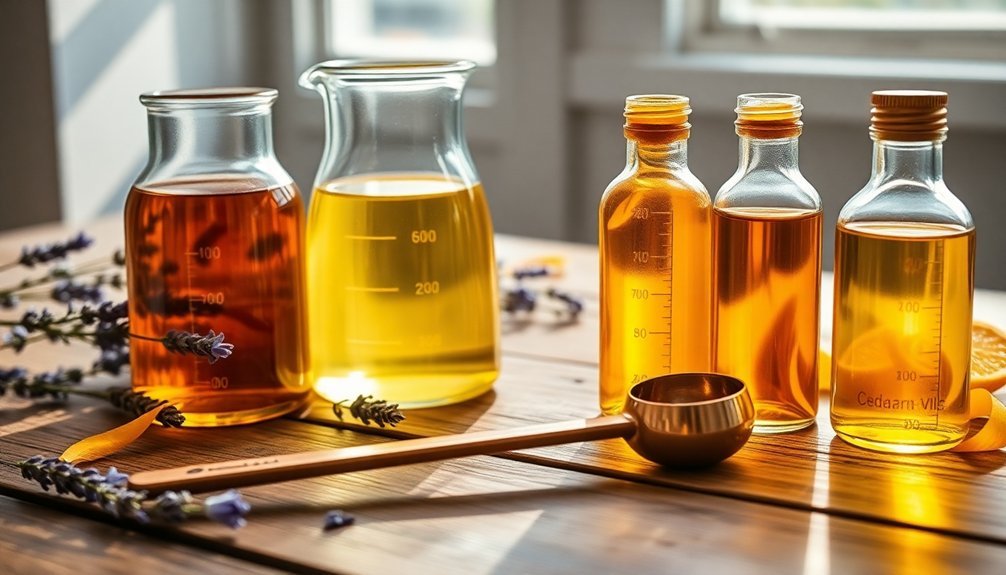
When creating aromatic combinations for your handmade soap, you'll want to start with a proven 25-50-25 ratio of top, middle, and base notes to guarantee a well-rounded fragrance profile.
Your top notes, like citrus oils, provide immediate impact while middle notes such as lavender or rosemary create the essential warmth and character that bridges your blend.
Give your oil mixture at least five minutes to settle before testing, and don't forget to verify safe usage rates with an essential oil calculator for the perfect balance in your final product.
Blending Essential Oil Ratios
To achieve a perfectly balanced essential oil blend, you'll need to follow the 25-50-25 rule: combining 25% top notes, 50% middle notes, and 25% base notes. This ratio guarantees your soap's scent remains stable and harmonious throughout its life.
When blending essential oils, consider using layering techniques to enhance complexity. Try pairing similar scents, such as combining lemon with Litsea Cubeba or orange with petitgrain.
For better scent retention, opt for 5-Fold citrus essential oils, which offer higher concentration. The recommended usage rate is 0.5 oz per pound of oil or fat in cold-process soap.
Keep track of your blending experiments in a notebook, recording your ratios and adjustments. This documentation will help you refine your formulations and consistently create successful essential oil combinations for your soap making projects.
Enhancing Scent Profile Depth
Creating depth in your soap's scent profile requires a strategic balance between middle and top notes, which work together to produce a complex and engaging aroma. You'll want to adjust your blending ratios to achieve the perfect harmony, typically using 25-50% of each note category for ideal results.
| Essential Oils | Note Type | Flash Point |
|---|---|---|
| Lavender | Middle | High |
| Rosemary | Middle | Medium |
| Lemon | Top | Low |
| Bergamot | Top | Low |
| Litsea Cubeba | Top | Medium |
To enhance scent longevity, combine oils with varying flash points. You'll find that layering similar essences, like pairing lemon with litsea cubeba, adds complexity to your fragrance profile. For a well-rounded blend, consider using 50% middle notes, complemented by equal parts top and base notes.
Testing Oil Combinations Together
Testing essential oil combinations requires a methodical approach to discover harmonious blends. Start by mixing equal parts of your selected essential oils, keeping detailed notes about each oil's unique characteristics and how they interact together.
When creating your blend, you'll want to incorporate both top notes for freshness and middle notes for warmth to achieve a well-rounded aroma. Use a fragrance wheel to guide your selection process, helping you identify complementary and analogous pairings that'll enhance your blend's complexity.
After combining your oils, let them mingle for at least five minutes before evaluating the scent profile. This waiting period allows you to fully assess how the oils work together and make any necessary adjustments to achieve your desired balance and depth.
Essential Oil Flash Points and Their Impact on Scent Longevity
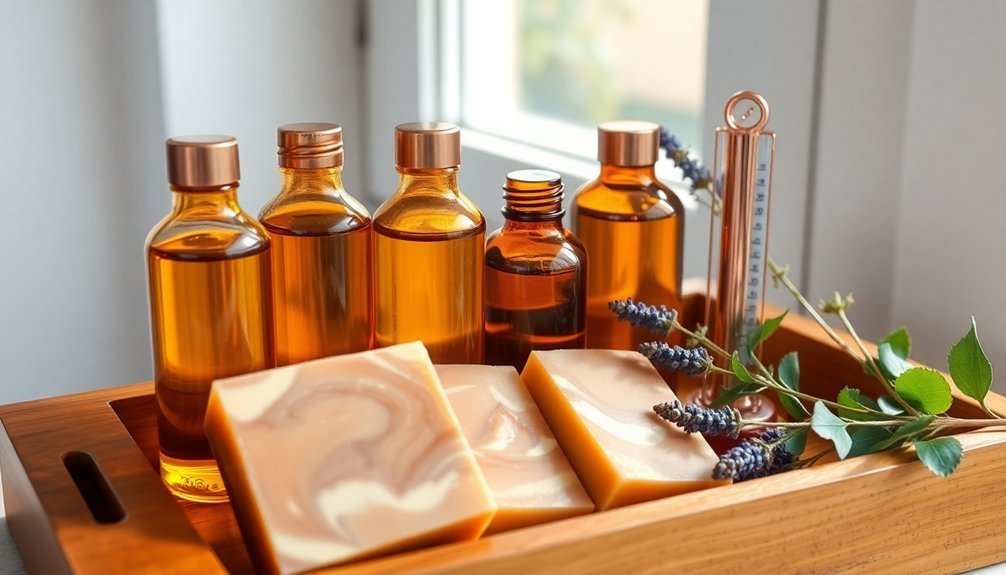
While many soap makers focus on selecting essential oils based on their fragrances alone, understanding flash points is crucial for achieving long-lasting scents in your final product.
To guarantee ideal scent longevity, you'll need to match essential oil flash points with your chosen soap-making method.
Successfully pairing essential oil flash points with your soap-making technique is key to creating products with lasting fragrance.
For cold-process and hot-process soap, select oils with flash points above 170°F to prevent fragrance loss during gelling and cooking phases.
If you're working with melt-and-pour soap, choose essential oils with flash points above 140°F to maintain scent integrity when pouring.
Don't forget to check supplier resources for flash point information before making your selections.
Clay Integration Methods for Enhanced Aroma Anchoring
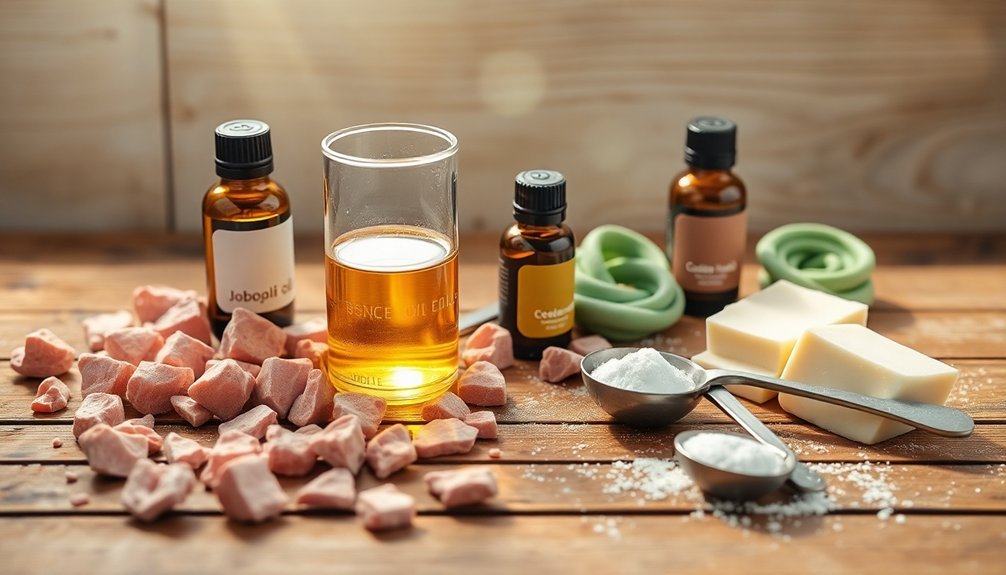
To maximize the staying power of your essential oil blends, you'll want to add one teaspoon of clay per pound of oils in your soap recipe.
You can enhance the integration process by first mixing your chosen essential oils with either Kaolin or Bentonite clay before adding the mixture to your soap batch.
Testing small batches with different clay-to-oil ratios will help you find the perfect balance for ideal scent retention while maintaining your soap's smooth texture.
Clay Ratios For Anchoring
Since achieving long-lasting fragrance proves challenging in soap making, incorporating clay serves as a reliable solution for anchoring essential oil blends. You'll find success by following the recommended ratio of 1 teaspoon of clay per pound of oils in your handcrafted soap.
For ideal scent retention, mix your essential oils with either Kaolin or Bentonite clay before adding them to your soap batch.
These clays excel at stabilizing aromas without affecting your soap's smooth texture. You'll discover that this pre-mixing technique creates a more uniform scent distribution throughout your final product.
Don't hesitate to experiment with different clay types and ratios to find your perfect blend. By mastering these clay proportions, you'll create soaps with lasting fragrances that maintain their appealing qualities from first use to last.
Essential Oil-Clay Mixing Techniques
As you prepare to mix essential oils with clay, mastering the proper integration technique will determine your soap's lasting fragrance.
You'll want to combine your essential oil blends with clay before adding them to your soap formulations, ensuring even distribution throughout your batch.
Start by measuring 1 teaspoon of clay per pound of oils in your recipe. Choose either Kaolin or Bentonite clay for their excellent absorbent properties.
Create a smooth paste by thoroughly blending your essential oils with the clay until there are no lumps. This pre-mixing step helps anchor your scents more effectively.
For best results, try small test batches to perfect your mixing techniques and observe scent retention.
You'll find that this method not only enhances fragrance longevity but also contributes to your soap's aesthetic appeal without compromising its gentle nature.
Natural Botanical Additives to Complement Oil Blends
Natural botanical additives offer a world of possibilities for enhancing your soap's sensory appeal and beneficial properties. When you're blending essential oils, consider adding gentle exfoliants like oatmeal to complement your scent profile while providing texture.
You'll find that botanical resins, particularly Balm of Gilead, work wonderfully to stabilize your soap's aroma and extend its lasting power.
For a unique twist in your soap making, try pairing cocoa butter with other natural botanical additives – it'll create a subtle mocha undertone while offering skin-conditioning benefits.
The creosote plant proves especially valuable, as its distinctive scent survives the saponification process. You can even experiment with food-based additions like bananas, which create interesting aromas when combined with cocoa butter, resulting in delightful scent combinations.
Testing Procedures for Essential Oil Combinations
While botanical additives enhance your soap's character, proper testing of essential oil combinations guarantees your final product achieves the perfect aroma.
Begin your testing procedures by creating individual scent strips for each essential oil, labeling them carefully to track their unique characteristics.
Follow these vital steps for accurate blend assessment:
- Create your blend and let it rest for at least 5 minutes to allow the scents to mingle properly.
- Gently waft the blend under your nose rather than inhaling directly to prevent olfactory fatigue.
- Document the ratios and your impressions immediately, noting how the aroma changes over time.
Don't rush to finalize your essential oil combination.
Return to test your blend after several hours or the next day, as scents can evolve markedly, affecting your soap's final fragrance profile.
Calculating Safe Usage Rates and Proportions
Every successful soap formulation depends on precise essential oil measurements to guarantee both safety and effectiveness.
You'll need to follow safe usage rates of 0.7 ounces per pound for cold-process soap, while hot-process methods require 0.3 ounces per pound.
To create balanced blends, use a parts-based system that's easy to scale up or down. Start by incorporating 25-50% base notes to anchor your scent, then adjust your proportions accordingly.
You'll want to track your blending ratios carefully for consistency in future batches.
Don't forget to use an Essential Oil Calculator to verify that your measurements fall within safe parameters for skin contact.
This tool helps you account for individual oil characteristics and potential sensitivities, ensuring your final product is both aromatic and safe for use.
Storage and Shelf Life Considerations for Oil Blends
Proper storage methods determine whether your essential oil blends maintain their therapeutic properties and aromatic qualities over time. To maximize shelf life and preserve quality, store your blends in dark glass bottles in a cool, dry place away from sunlight and heat sources.
Track your essential oils effectively by following these key steps:
- Label each blend with creation date and oil components
- Use an essential oil calculator to determine proper usage rates
- Store bottles in a dedicated storage area at consistent room temperature
Don't forget to regularly inspect your stored blends for any changes in scent or consistency. Most properly stored blends will last 1-3 years, but this varies based on the specific oils used.
If you notice any signs of degradation or rancidity, it's time to dispose of the blend and create a fresh batch.
Therapeutic Benefits of Strategic Oil Combinations
Strategic blending of essential oils reveals powerful therapeutic benefits that exceed their individual properties. You'll discover that combining specific essential oils enhances their therapeutic properties while creating unique effects for skin health and emotional well-being.
| Oil Combination | Benefits |
|---|---|
| Lavender + Patchouli | Calming, grounding, stress relief |
| Tea Tree + Eucalyptus | Antiseptic, respiratory support |
| Bergamot + Lemon | Energy boost, mood enhancement |
| Peppermint + Frankincense | Mental clarity, inflammation relief |
When you're crafting your soap blends, consider how citrus oils can energize your morning routine, while lavender essential oil combinations provide evening relaxation. These strategic combinations don't just smell amazing – they create synergistic effects that amplify each oil's natural benefits. You'll find that thoughtfully combined oils deliver superior results for both emotional balance and skin health.
Seasonal Blend Formulations for Year-Round Production
While understanding therapeutic oil combinations forms a strong foundation, adapting your soap blends to seasonal preferences can maximize their market appeal.
Creating successful seasonal blends requires strategic use of essential oils that reflect nature's changing aromatics. You'll want to incorporate 5-Fold citrus oils for lasting summer freshness, while adding warm spices and earthy base notes for winter formulations.
For ideal fragrance profiles in your handcrafted soap, consider these seasonal guidelines:
- Spring/Summer: Increase top notes with bright citrus and floral combinations
- Fall: Balance pumpkin and spice with grounding Patchouli
- Winter: Create depth using Frankincense and warm aromatics
Remember to adjust your ratios based on seasonal themes – lighter blends for warmer months and richer, more complex aromas for cooler seasons.
Frequently Asked Questions
What Essential Oil Blends Well Together for Soap?
You'll find that lavender pairs with almost anything, while rosemary works great with citrus. Try blending patchouli with florals, or mix bergamot with spicy notes. Litsea cubeba enhances other citrus oils perfectly.
What Is the 30/50/20 Rule for Essential Oils?
You'll want to blend your essential oils following the 30/50/20 rule: use 30% top notes for initial scent, 50% middle notes for the heart, and 20% base notes for lasting fragrance depth.
Which Oils Are Best for Soap Making?
You'll get great results using Lavender for its calming scent, Rosemary for freshness, and Litsea Cubeba for citrus notes. Don't forget to add base notes like Patchouli to help your soap's fragrance last longer.
What Essential Oils Should Not Be Used in Soap?
You shouldn't use cinnamon bark, clove, wintergreen, or strong citrus oils in soap. They can cause skin irritation, quick evaporation, or toxic reactions. Also avoid undiluted ylang ylang and jasmine essential oils.
In Summary
Now you've got the key elements for creating distinctive natural soap fragrances that'll delight your customers. Remember to balance your notes carefully, respect safe usage rates, and properly anchor your scents with complementary clays. By applying these blending principles and storage practices, you'll consistently produce soaps with lasting aromas and therapeutic benefits that work in harmony with your seasonal collections. Keep experimenting and refining your signature combinations.

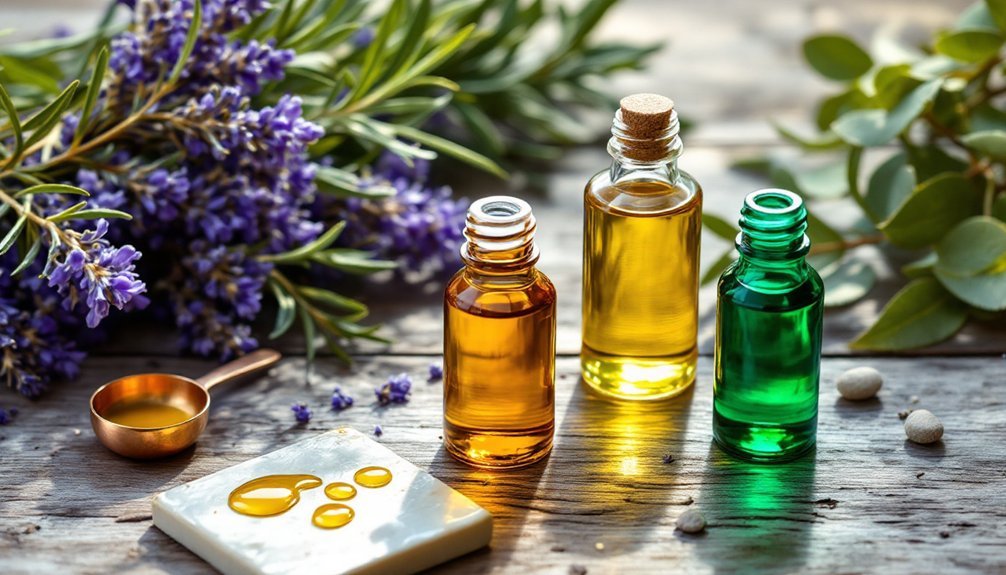



Leave a Reply